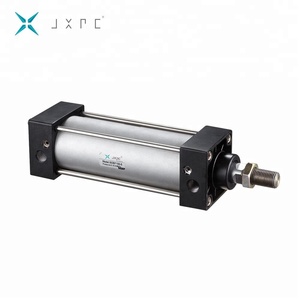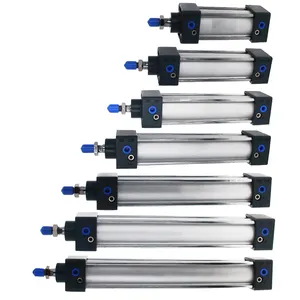
All categories
Featured selections
Trade Assurance
Buyer Central
Help Center
Get the app
Become a supplier

(1620 products available)





















Market Overview: The global market for pneumatic actuators, which includes rotary pneumatic actuators, was valued at approximately $3.4 billion in 2023 and is projected to grow to $4.6 billion by 2030, reflecting a compound annual growth rate (CAGR) of 4.7% during this period, according to Global Industry Analysts, Inc. This growth is driven by the increasing demand for automation across various industries, particularly in sectors like food and beverages, automotive, and oil and gas. The quarter-turn actuator segment, a critical component of rotary pneumatic actuators, is expected to reach $2.6 billion by 2030, growing at a notable CAGR of 5.9%. This indicates a robust market interest in efficient and reliable actuation solutions that enhance operational efficiency.
Regional Insights: The U.S. market for pneumatic actuators is anticipated to reach $903.0 million in 2023, signaling a significant player in the global landscape. In contrast, China is forecasted to grow at an impressive CAGR of 7.7%, reaching $1.0 billion by 2030, highlighting a shift towards increased automation and industrial efficiency in the region. The growing emphasis on minimizing energy consumption and optimizing performance in industrial applications is also influencing consumer behavior, as companies seek to adopt pneumatic actuators for their advantageous performance characteristics. Therefore, understanding these market dynamics and regional trends is crucial for stakeholders looking to capitalize on the expanding opportunities within the rotary pneumatic actuator segment.
A rotary actuator changes the arc of a valve by applying pneumatic power. In a rotary pneumatic actuator, compressed air is utilized to create rotational movement. An actuator transforms air pressure into twisting motion that opens and closes valves. The following three types of rotary pneumatic valve actuators are available for business uses:
Double-Acting Rotary Actuator:
A double-acting actuator allows compressed air to function in both directions to turn the valve completely. Pressurized air is situated on either side of the piston to rotate it in clockwise or counterclockwise direction. It provides high torque and quick valve articulation, making it well-suited for dealing with large volumes under pressure. The compact and easy-to-install design typically includes a direct-mount No. 5 Schonke for a 2-inch ball valve. It allows pre-setting of the open/close stop with a self-contained cylinder that has a 20,000 cycle balloon.
Spring Return Rotary Actuator:
A spring-return actuator uses compressed air to move the piston one way. A spring then returns it to its original position. This type of rotary actuator works well to close off a valve in an emergency or when there is loss of air pressure. It has a 30-inch-lb. spring torque that moves a ball valve with a 1/2 inch to 2-inch diameter. The actuator features an easily removable open/close limit switch enclosure that can be fastened with stainless steel connections.
Multi-Turn Pneumatic Actuator:
A multi-turn actuator rotates the valve so it can be opened and closed more than once by applying a specific amount of air pressure. An enclosed 2-stage gear box with a stroke limiter is utilized to achieve precise positioning. The housing is made out of die-cast aluminum with an anti-corrosive coating, which makes this actuator suitable for harsh environmental conditions. This actuator can also resist ambient temperatures ranging from -40 to 80 degrees centigrade. Compressed air creates high torsional force with energy efficiency through a 5/2 solenoid valve and adjustable exhaust port.
Torque:
Torques may vary depending on the size and pressure. Generally, 1,000 Nm to 25,000 Nm is common for larger 90-degree rotary actuators.
Operating Pressure:
An actuator may work between 2 and 8 bars or 30 and 115 psi. However, some models could have a range between 0 and 10 bars (0 to 145 psi)
Rotation Angle:
Generally, rotary actuator angle rotation is 90 or 180 degrees. But there are actuators with a range of up to 720 degrees
Speed:
The speed may vary from 3 to 12 seconds to fully open at 6 bars operating pressure. Some models may have a speed of 2 to 10 rpm.
Size:
For big torque applications, the dimension could be 6.7 x 9.1 x 11.42 in (17.0 x 23.0 x 29.0 cm), and for small torque applications, it could be 4.45 x 5.5 x 12.1 in (11.32 x 13.97 x 30.67 cm).
Depending on how often the device runs, regular maintenance is crucial for ensuring an actuator's lifespan. Each month, cleaning and greasing the actuator and making sure it operates at the right pressure can help to prolong the device's life. Every six months, users could do a thorough inspection. During the inspection, look for damage, replace the O-ring and padding if they have any leaks, and add grease to the bearings.
In addition to the above instructions, it's essential to keep the device working in optimal conditions. This means that the surrounding temperature shouldn't be below -20°C or above 60°C. Also, avoid humidity above 75%. To avoid any contamination inside the actuator, the air used should have a dew point of at least -20°C. Furthermore, avoid locating the actuator in a polluted environment with dust, salt, or chemicals. If any of these conditions are true, the user should consider installing a protective cover or a piping system to divert pollutants away from the actuator.
Finally, to avoid any actuator rotation loss, the user should secure any object attached to it with a good-fitting tolerance. Also, if the actuator is installed in a valve, make sure that the valve does not stress the actuator coupling. Ensure that the coupling is well-fitted with the valve blister.
Due to their strength and versatility, rotary pneumatic actuators have a wide variety of role-playing application scenarios. They are mainly used in the fields of HVAC industry valve control, food and beverage industry valve management, the chemical industry and pipeline mixing and pumping system industry.
When selecting the appropriate rotary pneumatic actuators, it is important to consider a number of characteristics, such as the required torque, the pressure range, the valve coupling options, the temperature and material compatibility, as well as the controls and feedback systems.
Q1: What is the difference between a rotary actuator and a rotary pneumatic actuator?
A1: The rotary actuator is the general term for devices that can turn objects. There are different types of actuators, including electrical, hydraulic, and pneumatic actuators. A rotary pneumatic actuator is a specific kind of actuator that uses air power to create movement.
Q2: Do rotary actuators have any limitations?
A2: Yes, there are some limitations to rotary actuators. They may not be able to turn as far as other types of actuators. Their turning speed could be slower. If the actuator is small, it might not support heavy loads. Also, actuators that are air-powered need a constant air supply to work.
Q3: Can a rotary actuator be repaired or is it replaceable only?
A3: Some rotary actuators can be repaired if their seals, gaskets, or inner components wear out. It's ideal to replace the actuator for a better long-term solution if the damage is severe or if the actuator is heavily used.
Q4: What factors affect the choice of a rotary actuator?
A4: The size, weight, and pressure handling capacity must be considered. If it needs to turn smoothly or quickly. Whether it will be used indoors or exposed to the elements. Lastly, the budget constraints and whether it needs to be electrically powered or could use air power should be considered.